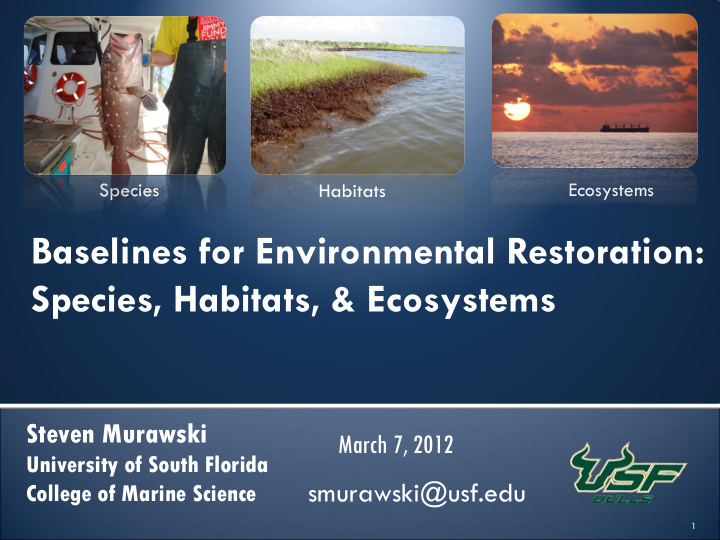



Ecosystems Species Habitats Baselines for Environmental Restoration: Species, Habitats, & Ecosystems Steven Murawski March 7, 2012 University of South Florida smurawski@usf.edu College of Marine Science 1
Overview Role(s) of environmental baselines in restoration planning for species, habitats and ecosystems Examples of the use of baselines in specific restoration and recovery programs Considerations in the choice and use of environmental baselines Filling the baseline “ Gap” : Importance of broad scale observing & research
Importance of Environmental Baselines Provide the scale against which to assess inj ury from specific natural or anthropogenic shocks Can (under certain circumstances) aid in setting obj ective, achievable goals for environmental restoration (e.g., end points) In combination with robust monitoring programs, baselines inform the choices of goals and traj ectories to achieving societal aims of restoration
Mangrove Losses in Florida All Florida Tampa Bay Biscayne Bay 0 20 40 60 80 100 Percent Loss Mangrove ecosystems are a major nursery Much of west Florida’s mangroves have been area for a wide array of biota and a carbon sink Lost, but can be restored using salt marsh restoration first as “nurseries” Chronic Resource Injury
Long-term wetlands loss Northern Gulf of Mexico Related to: Sediment starvation Channelization (oil & gas) Subsidence SLR Boesch et al.
Broad-scale context: Overlap of fish larvae and the BP spill Murawski/USF
Dissolved oxygen profiles for 419 validated profiles as compared to mean and standard deviation for 1 o ocean climatology for area around the wellhead. Vertical red dashed line indicates the DO 2 level for hypoxia (1.4 mL/L) source: World Ocean Atlas (NOAA) Acute & Local Resource Injury Such as deep DO in the Gulf of Mexico Hypoxic Level
Considerations in the Use of Baselines S hifting Baselines & the role of Complexity S electing Informative Baselines under environmental variation (un-achievable or set too low? Timelines of degradation & recovery Role of Adaptive Management Approaches
Carlos Duarte, et al. 2009. Return to Neverland: Shifting Baselines Affect Eutrophication Restoration Targets. Estuaries and Coasts DOI 10.1007/s12237-008-9111-2
When do we declare victory? California Sea Lion 11
Sometimes nominal baselines shoot too low….. Roles for models 20000 7000 Survey biomass (g/tow meats) Sea Scallops, U.S. Georges Bank Landings (mt meats) 6000 15000 5000 4000 10000 3000 2000 5000 1000 0 0 1960 1970 1980 1990 2000 Year
A Typical Stock Undergoing collapse…..and recovery Moratorium
Developing Indicators and Restoration Actions is an Exercise in Adaptive Management Baselines
Skin Ulcers on Red Snapper ^ Southern hake Conger eel tilefish Annual Reprt 2007-2008
Northern Gulf Can we substitute space for time? West Florida Shelf
Northern Gulf West Florida Shelf
Importance of Filling the Baseline “Gap” Many regions and issues have little to no • baseline monitoring For example, wrt Deepwater Horizon, • confounds injury assessment Robust but directed • Observing programs need to fill specific gaps
Recommend
More recommend